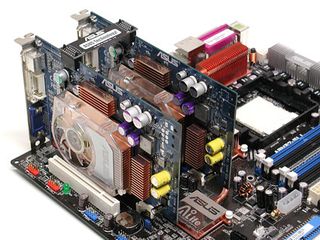ATI's Crossfire Xpress 3200 Chipset Takes Off
Dual Graphics Scaling Contest
What can you do with 32 PCI Express lanes? The answer to this question depends on which type of graphics card you intend to use. If you are talking about high-end products like the ATI Radeon X1800 or X1900, or the Nvidia GeForce 7800 GTX, the additional PCI Express bandwidth does not actually provide much of an advantage today. The reason is that these flagship products rely on their internal Crossfire cabling or SLI connections in order to communicate and to move rendered images from one card to the other in preparation for output to the display.
If, however, you intend to use a mid-range graphics card such as the ATI Radeon X1300 or the GeForce 6600 series, these can be operated in dual graphics mode without using their proprietary connection. And this also is where the benefit of two real x16 slots comes in: with the special connector not available, all the rendered data has to be moved via PCI Express. ATI needs to emphasize this fact, because its cable-linked Crossfire requires a Crossfire Master graphics card (which people would avoid buying if a regular model does the same job).
An issue for discussion is whether Nvidia's split-lane dual PCIe solution creates a bottleneck or not. The answer is yes, in certain cases. While Nvidia runs the link between the Northbridge and Southbridge at full 16x16 link width at 1 GT/s HyperTransport speed, the effective bandwidth does not reach the theoretical maximum. In addition, this link has to be used by all communications between the processor and I/O devices such as hard drives, optical drives, USB, networking, and so on. The bottom line is that yes, this can create a bottleneck, but it does not really matter as soon as you install your SLI bridge.

The little connector that links the two graphics cards is called an SLI bridge. If it is installed, an additional communication path is provided, which helps reduce the bandwidth requirements for PCI Express.

Ever since the 80.xx drivers were introduced, it has been possible to operate low-end and mid-class GeForce graphics cards in SLI mode without the SLI bridge.
Stay on the Cutting Edge
Join the experts who read Tom's Hardware for the inside track on enthusiast PC tech news — and have for over 25 years. We'll send breaking news and in-depth reviews of CPUs, GPUs, AI, maker hardware and more straight to your inbox.
Current page: Dual Graphics Scaling Contest
Prev Page Overclocking Contest: A8R32-MVP Vs. A8N32-SLI Next Page ATI CrossfireMost Popular

